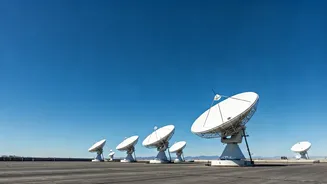India Testing Approval
Starlink, spearheaded by Elon Musk, has been granted the necessary testing permissions to initiate its operations within India. This approval is a crucial
step towards the company's ambition to offer its satellite-based internet services throughout the country. With these permissions in place, Starlink is authorized to begin testing its infrastructure, setting the stage for a potential full-scale launch. The initial phase involves the setup of at least 9 satellite stations, strategically positioned to provide coverage and assess the network's performance. This testing phase will evaluate various aspects, from signal strength and reliability to overall user experience, ensuring that the service meets the required standards before a wider rollout. The permissions mark a milestone in Starlink's endeavors to expand its global footprint and offer internet access to underserved areas.
Strategic Infrastructure Setup
To support its India launch, Starlink plans to establish a network of 9 satellite stations. These stations will serve as the backbone of the internet service, facilitating the connection between the satellites in space and the ground-based infrastructure. The strategic placement of these stations is crucial to ensure optimal coverage and performance across diverse geographical regions. These satellite stations will manage the inflow and outflow of data, connecting the satellites to the wider internet network. The company will need to ensure that these stations are equipped with the required technology and infrastructure to manage the high bandwidth and data transmission demands of Starlink's service. The careful planning and deployment of these stations is vital for the success of Starlink in India, as it will determine the quality and accessibility of its internet service for the end-user.
Target User Base & Locations
Starlink's internet service is poised to target a wide user base, catering to both urban and rural areas across India. Initial testing and deployments will prioritize key locations, including major cities and strategic zones. It's anticipated that Starlink will aim to provide its high-speed internet to residential users, businesses, and government organizations. The initial locations earmarked for the launch include Mumbai, Noida, Kolkata, and Lucknow, suggesting an early focus on metropolitan areas. These locations were chosen for their strategic importance and population density. The expansion strategy will likely involve phase-wise launches, with the service gradually becoming available in additional cities and regions. The company's focus on both urban and rural areas will enable it to address the digital divide and offer connectivity options to remote areas.
Expected Plans & Pricing
Details regarding the exact pricing plans and subscription options for Starlink's services in India are yet to be announced. However, expectations suggest that the pricing structure will be competitive, taking into account the existing internet service rates and the cost of satellite internet technology. Starlink is likely to offer various plans catering to different user needs, possibly including options based on data allowance, speed, and additional features. The pricing will be influenced by factors such as the cost of setting up and maintaining the infrastructure, as well as the operational costs involved in providing satellite internet services. The specific plans may vary depending on the target market, with separate packages for residential, business, and enterprise customers. The company will likely provide a range of plans to attract a wide user base.
Internet Speed Expectations
One of the key selling points of Starlink's satellite internet service is its promise of delivering high-speed internet connectivity. The company has indicated that users in India can expect a range of internet speeds, allowing for activities such as streaming, online gaming, and video conferencing. The actual speeds will depend on various factors, including the number of users connected, geographical location, and the density of satellite coverage in the specific area. While Starlink aims to provide consistent high-speed internet, real-world performance may vary, particularly in the initial phases of deployment. As the network matures and the satellite infrastructure expands, the internet speeds are likely to improve over time. Starlink's objective is to provide fast and reliable internet access to both urban and rural users, improving connectivity.
















